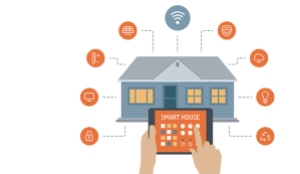The term ‘smart’ is applied in many different environments, and often involves connected sensors and devices sending lots of data which can then be acted upon for the benefit of the environment or people in that environment. In this article, we look at an example of IoT in a smart home, and how it can effectively help the wellness of residents living in that home.
By Anita Lankinen

In traditional houses inhabitants act as ‘living sensors’ for indoor condition problems. In most cases air quality, humidity level, CO2 concentration and other indoor measurements are analyzed only after complaints from tenants regarding headaches or some respiratory symptoms. However, even mild symptoms may signify the development of severe lifetime sicknesses like asthma.
We now live in a world of smart homes and connected objects. However, true value comes from even smarter means. Whereas the Internet of things (IoT) is at large about simply connecting every thing, more can and should be done when it comes to analyze and control.
The existing ‘smart home’ solutions and wellness
Things, as well as people, are influenced by their environment, and the environment and other conditions change over time. That’s why it is essential to record the entire lifecycle of a building and the people (and things) living in it. On top of all that stored data, smart algorithms will enable automatic awareness of any changes and create predictions for the future. This creates a virtual ‘smart counterpart’ of the entire building. This counterpart is known as spime, a term originally coined by author Bruce Sterling. It is defined as ‘a futuristic object that can be tracked through space and time throughout its lifetime’.
However, spimes are nothing futuristic anymore. They are already out there and in use throughout all kinds of industries – construction industry included. Global IoT operator BaseN has already spime’d houses in The Netherlands in cooperation with construction giant VolkerWessels. Building components of the newly built houses, such as heat pumps and ventilation units, were equipped with sensors. Their lifetime data is gathered from the very beginning and correlated through other conditions inside and outside the building.
Access to this data is provided both to the tenants and the facility management. The building’s energy and water consumption and environmental conditions (CO2 concentration, indoor temperature and humidity level) are managed through the building’s spime. The spime, for example, automatically adjusts ventilation if the level of CO2 concentration in the house is detected to be too high. The tenants are also able to access all the information on air quality through their customer portals. In addition, production measurements of the rooftops’ PV cells are fed to the spime, providing useful performance data to facility management as well.
The fact that the spimes record the full lifetime history of the houses allows tracking changes in energy consumption and environmental patterns over time. This enables optimization of various settings, ensures preventive maintenance in case of suboptimal performance of equipment, and gives full transparency to both the tenants and the service company. BaseN manages the collection, storage, analysis, control and visual presentation of real-time data from device-specific smart meters (e.g. washing machine, laundry dryer, stove, oven) and sensor-equipped building components (e.g. heat pumps, ventilation units).
The future of spime’d houses
There are still improvements which can be done both during a building’s maintenance and construction phase to make the houses ‘smart’. Existing energy and water consumption management systems can be complemented by additional features, thus providing more security to prevent e.g. water leakages in the apartments. This can be done by introducing a ‘home away’ feature, which notifies the tenant when water is consumed at home, while he or she is away. The feature has already been implemented in another project, Adjutantti, the first of its kind low-energy apartment house in Finland.
During construction works quality of building materials might be influenced by various factors: the woods can be partially wet after heavy rains at the construction site and the concrete can be utilized by the workers when it is not at the appropriate level of dryness. However, due to scheduling issues, constructors are often pressured to use the materials when those are not in a perfect state.
Spiming building materials during the construction phase will help solve this challenge. Additionally, sensors kept in the concrete also after the house construction has been finalized, allow for constantly analyzing the moisture levels of a building’s walls, thereby ensuring that the house ‘breathes’ the way it should.
The most important aspect, though, is the effect on the quality of life of the building’s inhabitants. Their home’s spime will always ensure that they live in perfect living conditions automatically adjusting, e.g. temperature and lighting, and will allow for immediate preventive action, e.g. in the case of deterioration of air quality. The home becomes an active enabler of a person’s health, wellbeing and happiness. That is what makes a smart home truly smart.
Anita Lankinen is with BaseN Corporation.